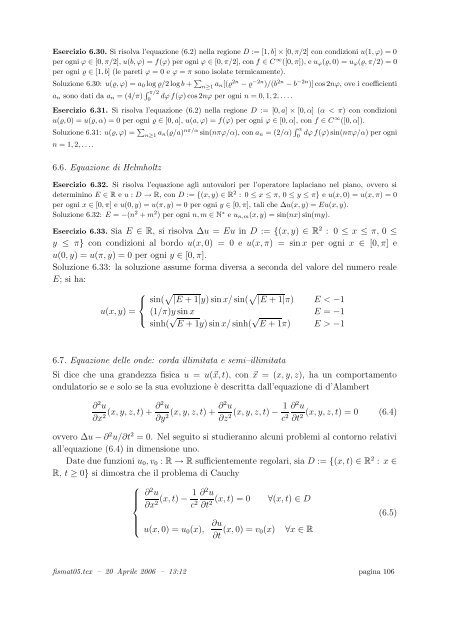Esercizi e appunti per il corso di Fisica Matematica - Sezione di ...
Esercizi e appunti per il corso di Fisica Matematica - Sezione di ...
Esercizi e appunti per il corso di Fisica Matematica - Sezione di ...
You also want an ePaper? Increase the reach of your titles
YUMPU automatically turns print PDFs into web optimized ePapers that Google loves.
<strong>Esercizi</strong>o 6.30. Si risolva l’equazione (6.2) nella regione D := [1, b] × [0, π/2] con con<strong>di</strong>zioni u(1, ϕ) = 0<strong>per</strong> ogni ϕ ∈ [0, π/2], u(b, ϕ) = f(ϕ) <strong>per</strong> ogni ϕ ∈ [0, π/2], con f ∈ C ∞ ([0, π]), e u ϕ (ϱ, 0) = u ϕ (ϱ, π/2) = 0<strong>per</strong> ogni ϱ ∈ [1, b] (le pareti ϕ = 0 e ϕ = π sono isolate termicamente).Soluzione 6.30: u(ϱ, ϕ) = a 0 log ϱ/2 log b + ∑ n≥1 a n[(ϱ 2n − ϱ −2n )/(b 2n − b −2n )] cos 2nϕ, ove i coefficientia n sono dati da a n = (4/π) ∫ π/20dϕ f(ϕ) cos 2nϕ <strong>per</strong> ogni n = 0, 1, 2, . . . .<strong>Esercizi</strong>o 6.31. Si risolva l’equazione (6.2) nella regione D := [0, a] × [0, α] (α < π) con con<strong>di</strong>zioniu(ϱ, 0) = u(ϱ, α) = 0 <strong>per</strong> ogni ϱ ∈ [0, a], u(a, ϕ) = f(ϕ) <strong>per</strong> ogni ϕ ∈ [0, α], con f ∈ C ∞ ([0, α]).Soluzione 6.31: u(ϱ, ϕ) = ∑ n≥1 a n(ϱ/a) nπ/α sin(nπϕ/α), con a n = (2/α) ∫ αdϕ f(ϕ) sin(nπϕ/α) <strong>per</strong> ogni0n = 1, 2, . . . .6.6. Equazione <strong>di</strong> Helmholtz<strong>Esercizi</strong>o 6.32. Si risolva l’equazione agli autovalori <strong>per</strong> l’o<strong>per</strong>atore laplaciano nel piano, ovvero sideterminino E ∈ R e u : D → R, con D := {(x, y) ∈ R 2 : 0 ≤ x ≤ π, 0 ≤ y ≤ π} e u(x, 0) = u(x, π) = 0<strong>per</strong> ogni x ∈ [0, π] e u(0, y) = u(π, y) = 0 <strong>per</strong> ogni y ∈ [0, π], tali che ∆u(x, y) = Eu(x, y).Soluzione 6.32: E = −(n 2 + m 2 ) <strong>per</strong> ogni n, m ∈ N ∗ e u n,m (x, y) = sin(nx) sin(my).<strong>Esercizi</strong>o 6.33. Sia E ∈ R, si risolva ∆u = Eu in D := {(x, y) ∈ R 2 : 0 ≤ x ≤ π, 0 ≤y ≤ π} con con<strong>di</strong>zioni al bordo u(x, 0) = 0 e u(x, π) = sin x <strong>per</strong> ogni x ∈ [0, π] eu(0, y) = u(π, y) = 0 <strong>per</strong> ogni y ∈ [0, π].Soluzione 6.33: la soluzione assume forma <strong>di</strong>versa a seconda del valore del numero realeE; si ha:⎧⎨ sin( √ |E + 1|y) sin x/ sin( √ |E + 1|π)u(x, y) = (1/π)y sin x⎩sinh( √ E + 1y) sin x/ sinh( √ E + 1π)E < −1E = −1E > −16.7. Equazione delle onde: corda <strong>il</strong>limitata e semi–<strong>il</strong>limitataSi <strong>di</strong>ce che una grandezza fisica u = u(⃗x, t), con ⃗x = (x, y, z), ha un comportamentoondulatorio se e solo se la sua evoluzione è descritta dall’equazione <strong>di</strong> d’Alambert∂ 2 u∂x (x, y, z, t) + ∂2 u2 ∂y (x, y, z, t) + ∂2 u2 ∂z (x, y, z, t) − 1 ∂ 2 u(x, y, z, t) = 0 (6.4)2 c 2 ∂t2 ovvero ∆u − ∂ 2 u/∂t 2 = 0. Nel seguito si stu<strong>di</strong>eranno alcuni problemi al contorno relativiall’equazione (6.4) in <strong>di</strong>mensione uno.Date due funzioni u 0 , v 0 : R → R sufficientemente regolari, sia D := {(x, t) ∈ R 2 : x ∈R, t ≥ 0} si <strong>di</strong>mostra che <strong>il</strong> problema <strong>di</strong> Cauchy⎧∂ 2 u⎪⎨ ∂x (x, t) − 1 ∂ 2 u(x, t) = 0 ∀(x, t) ∈ D2 c 2 ∂t2 ⎪⎩u(x, 0) = u 0 (x),∂u∂t (x, 0) = v 0(x)∀x ∈ R(6.5)fismat05.tex – 20 Apr<strong>il</strong>e 2006 – 13:12 pagina 106
















